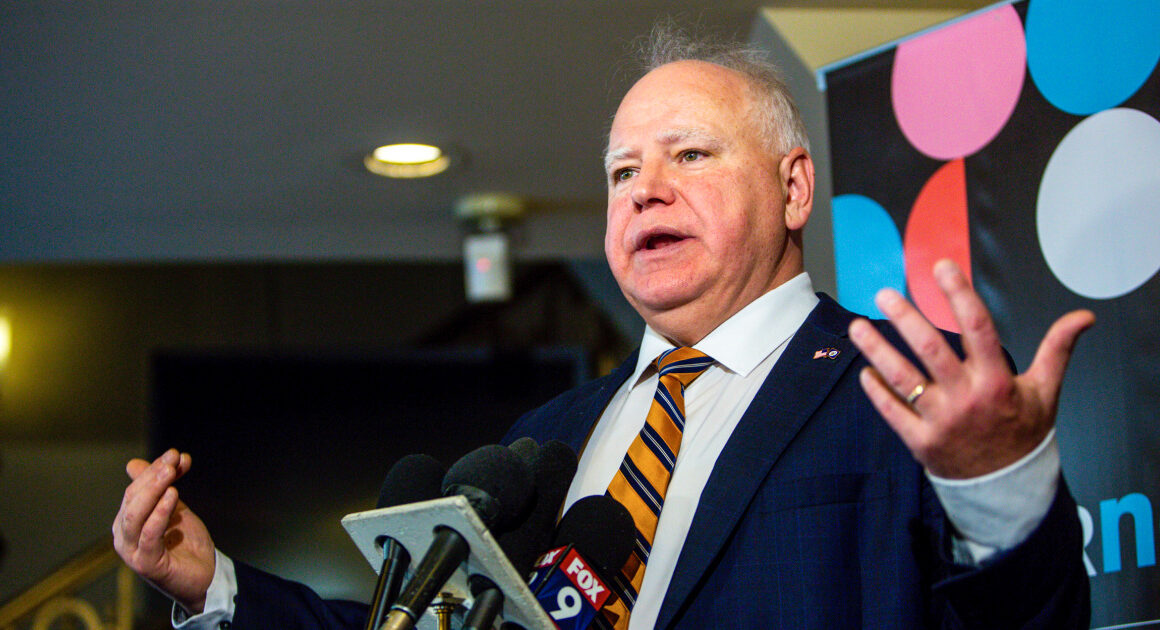Vice President Kamala Harris’ tactical calculation with her running mate pick is that Minnesota Gov. Tim Walz could provide a decisive boost in Wisconsin, Michigan and Pennsylvania — three states that, if Democrats can hold on to them, would make their ticket highly likely to win.
One of the Democrats’ chief challenges in those states is in blue-collar and small-town areas, where the party once ran competitively (or at least respectably) before the floor fell out amid and after Donald Trump’s emergence in 2016. The thinking is that Walz’s story and style will be relatable and reassuring to some of those voters, blunting at least part of the Trump GOP’s newfound dominance.
There’s a catch, though: Walz wasn’t able to do that himself in his last campaign.
Demographically, Minnesota has substantial overlap with Wisconsin, Michigan and Pennsylvania. All feature large white voting populations defined by massive splits along class lines — with college-educated white voters becoming more Democratic and white voters without four-year degrees becoming more Republican. The reason Minnesota hasn’t attained battleground status like the three others is that it has a higher share of the college-educated, Democratic-friendly cohort.
Walz won his 2022 re-election bid 52%-44% over his Republican foe. That’s virtually the same as the 52%-45% margin Joe Biden carried the state by in 2020.
Walz put up those numbers in a worse year for Democrats, to be sure. But did he attain that 52% with a different coalition from Biden’s — one less skewed toward the well-educated Twin Cities area, with broader support in the small cities and towns of Greater Minnesota? If he did, it would buttress the notion that he has a strong and unique connection with the exact type of voter Democrats have been shedding in those three key battleground states.
One way to measure that is by looking at county-level results. Forty-nine of Minnesota’s 87 counties might be considered “Trump surge” counties; that is, Republicans ran at least 20 points better there under Trump in 2016 and 2020 than they had in the 2012 election, when Mitt Romney was the GOP nominee. Those counties are all part of Greater Minnesota, many are rural, and virtually all are overwhelmingly white. The share of white adults without four-year degrees in those counties 72% to 85%.
Demographically, those counties almost perfectly fit the mold of the swaths of Wisconsin, Michigan and Pennsylvania where Democrats have lost the most ground in the Trump era. They were also, before Trump, politically competitive, and some even voted for Barack Obama in 2012. In other words, these are the first counties you’d look at to assess whether Walz has unique appeal where his party has experienced its most dramatic Trump-era slide.
But here is how Walz’s performance in them compares to Biden’s in 2020 and Obama’s in 2012.
There’s no obvious difference between Walz’s strength in those areas and what Biden showed in 2020.
Then there’s the flip side. There are eight Minnesota counties that you might call “blue surge” counties — the only places in the state where Democrats performed better in 2020 under Biden than they had in 2012 under Obama. They include the heart of the Twin Cities (Hennepin and Ramsey counties, home of Minneapolis and St. Paul) and their densely populated, college degree-rich suburbs.
Again, the difference between Walz and Biden is negligible. Their numbers speak to the deepening concentration of Democratic loyalty found in suburbs all across the country since the emergence of Trump.
What’s striking, if anything, is how different the Walz and Biden numbers are from Obama’s. When Obama won his two elections, he joined strong metro-area support with respectable showings (and sometimes better) among small-town and blue-collar voters. A primary feature of American politics since Obama has been the virtual disappearance of that kind of demographic and geographic balance from the Democratic coalition.
In his ’22 campaign, Walz didn’t restore that old balance. His coalition, instead, looked just like what has become the standard post-Obama coalition for Democrats. He rolled up massive margins in metro areas and took a beating practically everywhere else.
None of this is to say the Harris-Walz ticket won’t be able to win Wisconsin, Pennsylvania and Michigan. It very well may. But to boost the ticket in those states beyond what has become the Democratic Party norm, Walz will need to break through Trump-era polarization in the kinds of places he wasn’t able to do it in 2022.
,







